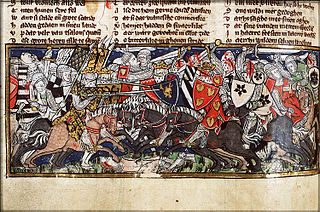Related Research Articles

The Huns were a nomadic people who lived in Central Asia, the Caucasus, and Eastern Europe between the 4th and 6th century AD. According to European tradition, they were first reported living east of the Volga River, in an area that was part of Scythia at the time; the Huns' arrival in Europe is associated with the migration westward of an Iranian people, the Alans. By 370 AD, the Huns had arrived on the Volga, and by 430, they had established a vast, if short-lived, dominion in Europe, conquering the Goths and many other Germanic peoples living outside of Roman borders and causing many others to flee into Roman territory.

Uldin, also spelled Huldin is the first ruler of the Huns whose historicity is undisputed.

Laudaricus was a prominent Hunnic chieftain and general active in the first half of the 5th century.
Basich or Basikh was a Hun military commander who co-led an invasion of Persia in 395 AD together with Kursich.
Kursich was a Hun general and royal family member. He led a Hunnish army in the Hunnic invasion of Persia in 395 AD.
Chelchal was a Hun commander serving as lieutenant general under the Byzantine Empire.
Odolgan was a Hun commander serving under the Byzantine Empire. He was the commander of the garrison of Perugia.
Sanoeces was a Hun military leader serving as general under the Western Roman Empire.
Sigizan was a Hun general in the Byzantine army.
Tarrach was a Hun military officer for the East Roman Empire. He was the assassin of the officer Cyril. Tarrach was credited as the "fiercest of the Huns".
Turgun was a military officer of Hunnish descent of the Byzantine Empire.
Uldach was a general of the Byzantine Empire of Hunnish descent.
Zilgibis was a ruler of the North Caucasian Huns.
Ultzindur was a Hun nobleman and a blood relative of Attila.
Gordas was a prince of the Crimean Huns.
Althias was a Hun military commander in the Byzantine Empire. He is noted for defeating Iaudas, king of the Moors, and his army with just 70 men.
Elmingir also Elminegeir, Elmingeir was a Hun general fighting for the Byzantine Empire.
Hormidac was a military leader of the Huns, who commanded an expedition against the Eastern Roman Empire in the winter of 466/467. He raided Dacia mediterranea before being defeated by Anthemius.
Apsich or Aspik was a Hun military leader in the Byzantine Empire.
Bochas was a Hun officer of the guard under Belisarius.
References
- ↑ Maenchen-Helfen, Otto J. "The World of the Huns. Chapter IX. Language". www.kroraina.com. Retrieved 27 October 2022.
- ↑ Winsor, Justin; Creighton, Mandell; Lane Poole, Reginald; Gardiner Rawson, Samuel; Goronwy Edwards, Sir John, eds. (1893). The English Historical Review Volume 8. Oxford University Press. p. 234. Retrieved 27 October 2022.
- ↑ Maenchen-Helfen, Otto J. (2022). Knight, Max (ed.). The World of the Huns Studies in Their History and Culture. University of California Press. p. 383. ISBN 9780520357204 . Retrieved 27 October 2022.
- ↑ Maenchen-Helfen, Otto J. "The World of the Huns. Chapter IX. Language". www.kroraina.com. Retrieved 27 October 2022.
- 1 2 3 Syvänne, Ilkka (2021). Military History of Late Rome 457-518. Pen & Sword Books Limited. p. 170. ISBN 9781473895355 . Retrieved 6 November 2022.
- ↑ Laing, Jennifer; Laing, Lloyd (2000). Warriors of the Dark Ages. Sutton. p. 46. ISBN 9780750919203 . Retrieved 6 November 2022.
- ↑ Jones, Arnold Hugh Martin; Martindale, J. R.; Morris, John (1971). The Prosopography of the Later Roman Empire: Volume 2, AD 395-527. Cambridge University Press. p. 1205. Retrieved 6 November 2022.
- ↑ Maenchen-Helfen, Otto J. "The World of the Huns. Chapter IX. Language". www.kroraina.com. Retrieved 5 November 2022.